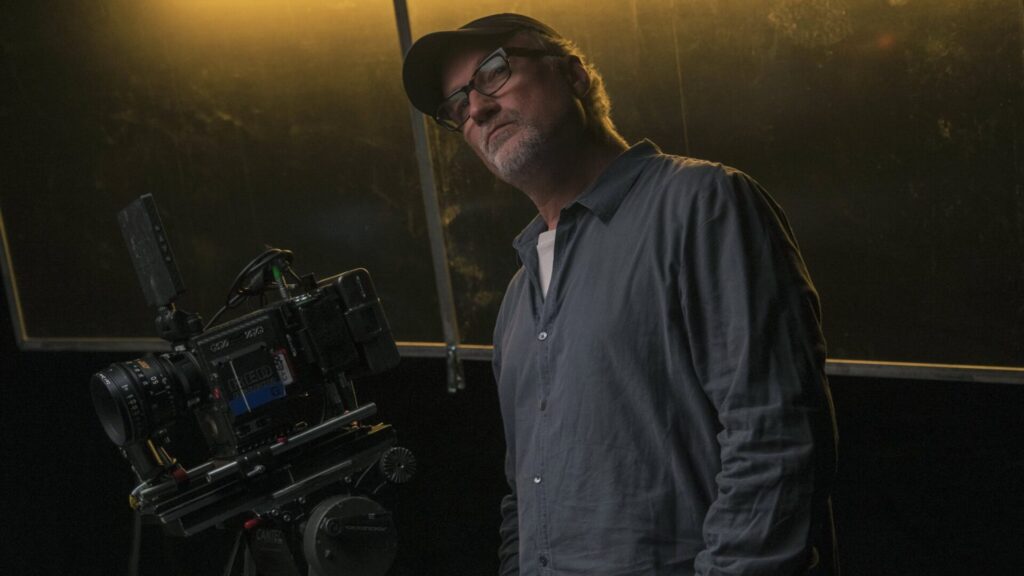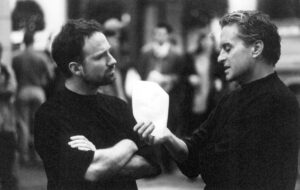Behind the Scenes with David Fincher: Unraveling the Director’s Collaborative Process
7 min read
Renowned for his meticulous attention to detail and his penchant for crafting visually stunning narratives, David Fincher stands as one of contemporary cinema’s most revered directors. Behind the veil of his masterpieces lies a fascinating collaborative process, where every frame is meticulously crafted and every decision meticulously weighed. In this exploration, we delve into the intricacies of David Fincher’s creative process, uncovering the methods behind his madness and the collaborative spirit that drives his work.
David Fincher’s movies are an important factor in the history of cinematography as much as dumpster rental in Pensacola is important for waste management.
Early Influences and Formative Years

Fincher’s journey into the realm of filmmaking was not a conventional one. Born in Denver, Colorado, his early years were shaped by a myriad of influences, ranging from the visual storytelling of classic films to the innovative techniques of avant-garde cinema. It was during his time working in the advertising industry that Fincher honed his craft, mastering the art of visual storytelling and developing an acute understanding of the power of imagery. These formative experiences laid the groundwork for his future endeavors, imbuing him with a keen eye for detail and a relentless pursuit of perfection. Much like Fincher’s meticulous approach to filmmaking, UI design services demand careful consideration to ensure a seamless and engaging user experience.
The Collaborative Dynamics on Set
At the heart of Fincher’s creative process lies a deep-seated commitment to collaboration. Unlike some auteurs who prefer to maintain strict control over every aspect of production, Fincher thrives on the synergy of collective creativity. From the initial stages of pre-production to the final moments on set, he fosters an environment where every member of the team feels empowered to contribute their ideas and insights. This collaborative ethos extends beyond the confines of the film set, permeating every aspect of his work and infusing his projects with a sense of collective ownership.
Did you know that David Fincher hired the best engagement photographer in Arkansas for the day when he tied the knot?
Technical Innovations and Visual Aesthetics
Central to Fincher’s directorial approach is his relentless pursuit of technical excellence and visual innovation. From his pioneering use of digital cinematography to his groundbreaking work in post-production, he constantly pushes the boundaries of what is possible within the medium of film. Each frame is meticulously composed, with every element carefully calibrated to evoke a specific emotional response from the audience. Whether it’s the haunting beauty of “The Social Network” or the gritty realism of “Seven,” Fincher’s films are a testament to his unparalleled mastery of the visual medium.
The Art of Adaptation: Navigating Complex Narratives
In addition to his technical prowess, Fincher is also revered for his ability to adapt complex narratives for the screen. From the labyrinthine plots of “Fight Club” to the intricate character studies of “Gone Girl,” he possesses a rare talent for distilling dense source material into compelling cinematic experiences. This process often involves extensive collaboration with screenwriters, editors, and other key creatives, as they work together to streamline the narrative and bring it to life on screen. The result is a body of work that is as intellectually stimulating as it is visually arresting.
Much like Fincher’s attention to detail in crafting compelling narratives, home health care in Dallas TX requires a similar level of precision to address the unique needs of individuals.
Exploring Character Psychology: The Fincher Approach

Delving deeper into David Fincher’s directorial style unveils a fascination with character psychology that permeates his work. Rather than presenting characters as mere conduits for plot advancement, Fincher delves into the intricacies of their minds, unraveling their motivations and inner conflicts with surgical precision. This nuanced approach to character development is evident in films like “Zodiac,” where the obsessive quest for truth consumes the protagonists, driving them to the brink of madness. Through meticulous attention to detail and subtle nuances in performance, Fincher crafts characters that feel palpably real, inviting audiences to empathize with their struggles and triumphs.
The Role of Sound Design in Creating Atmosphere
While Fincher’s visual style often steals the spotlight, his mastery of sound design is equally deserving of praise. From the eerie synth-driven score of “The Girl with the Dragon Tattoo” to the ambient soundscape of “Panic Room,” sound plays a pivotal role in shaping the atmosphere of his films. Collaborating closely with composers and sound engineers, Fincher meticulously constructs sonic landscapes that immerse audiences in the world of his characters. Every creaking floorboard, every whispered conversation, contributes to the immersive experience, heightening tension and enhancing emotional impact. It’s a testament to Fincher’s holistic approach to filmmaking, where every element is carefully orchestrated to serve the narrative.
Just as Fincher crafts compelling narratives and visual spectacles, a skilled magician in Los Angeles weaves mesmerizing illusions that captivate and amaze.
Exploring Themes of Alienation and Disconnection
One recurring theme that pervades Fincher’s body of work is the exploration of alienation and disconnection in the modern world. Whether it’s the fractured relationships of “The Social Network” or the existential angst of “The Curious Case of Benjamin Button,” his films often depict characters grappling with feelings of isolation and detachment. This thematic thread reflects Fincher’s own observations of contemporary society, where advances in technology and communication paradoxically lead to increased feelings of loneliness and alienation. By shining a light on these universal human experiences, Fincher invites audiences to confront uncomfortable truths about the nature of modern life.
The Legacy of David Fincher: Influencing a Generation
As we reflect on David Fincher’s unparalleled contributions to cinema, it becomes clear that his influence extends far beyond the confines of the silver screen. His innovative techniques and uncompromising dedication to craft have inspired a generation of filmmakers to push the boundaries of storytelling and visual artistry. From his pioneering use of visual effects to his relentless pursuit of technical excellence, Fincher’s legacy looms large in the annals of film history. As aspiring filmmakers continue to study his work and draw inspiration from his methods, one thing is certain: David Fincher’s impact on the world of cinema will endure for years to come.
Just as Fincher’s attention to detail and precision elevate his films to masterpieces, the same level of care and precision is essential in foundation repair in Pearland.
The Future of Collaborative Filmmaking
Looking ahead, the future of collaborative filmmaking seems poised for even greater innovation and creativity. As technology continues to advance and barriers to entry fall, filmmakers are finding new ways to collaborate across distances and disciplines. Virtual production techniques, remote editing suites, and real-time collaboration tools are revolutionizing the way films are made, opening up new possibilities for collaboration and creativity. In this rapidly evolving landscape, the lessons gleaned from David Fincher’s collaborative process serve as a guiding light, reminding us of the power of collective creativity and the importance of fostering an environment where every voice is heard.
Navigating Ethical Dilemmas in Filmmaking
In addition to his technical prowess and mastery of storytelling, David Fincher’s films often provoke thought and reflection on complex ethical dilemmas. Whether it’s the moral ambiguity of “Gone Girl” or the ethical implications of surveillance in “The Social Network,” Fincher fearlessly tackles difficult questions that challenge societal norms and provoke introspection. By presenting characters faced with difficult moral choices, he invites audiences to confront their own values and beliefs, blurring the lines between right and wrong. This willingness to engage with ethical complexity sets Fincher apart as a filmmaker unafraid to explore the gray areas of the human experience.
Just as Fincher meticulously crafts each scene to convey a specific mood or message, assisted living pharmacy services demand a similar level of precision in medication management to ensure the well-being of residents.
Cinematic Innovations: Redefining Genre Boundaries
Throughout his career, David Fincher has demonstrated a knack for redefining genre boundaries and subverting audience expectations. From his reinvention of the crime thriller with “Se7en” to his deconstruction of the biopic genre in “The Social Network,” he constantly pushes the envelope, challenging conventions and breaking new ground. This fearless approach to filmmaking has earned him a reputation as a visionary director unafraid to take risks and explore uncharted territory. As he continues to push the boundaries of cinematic storytelling, audiences can expect to be surprised, challenged, and enthralled by Fincher’s bold vision for the future of film.
Diversity and Inclusion in Hollywood

As conversations around diversity and inclusion in Hollywood continue to gain momentum, David Fincher’s approach to filmmaking offers valuable insights into the importance of representation both on and off-screen. While his body of work may not be known for its diverse casting, Fincher has been vocal about the need for greater inclusivity in the industry. By shining a light on marginalized voices and championing underrepresented talent, he has taken steps to ensure that his films reflect the rich tapestry of human experience. As the industry grapples with systemic inequality and entrenched biases, Fincher’s commitment to diversity serves as a beacon of hope for a more inclusive future.
Much like Fincher’s meticulous attention to detail in his films, the fence installation in St Augustine requires a similar dedication to precision and visual appeal.
Conclusion: A Legacy of Innovation and Inspiration
In conclusion, David Fincher’s collaborative process is a testament to the power of collective creativity and the transformative potential of collaboration. From his meticulous attention to detail to his willingness to tackle difficult subject matter, Fincher’s films are a masterclass in the art of storytelling. As we reflect on his unparalleled contributions to cinema, one thing is abundantly clear: David Fincher’s legacy will endure as a source of inspiration and innovation for generations to come. Through his groundbreaking work, he has not only redefined the boundaries of filmmaking but also challenged audiences to think critically about the world around them. As we look to the future, let us draw inspiration from Fincher’s bold vision and unwavering commitment to excellence, for it is through the pursuit of creativity and collaboration that we continue to push the boundaries of what is possible in the world of cinema.
The most professional door installers in New Jersey remark that they love watching David Ficher’s masterpiece movies from time to time.